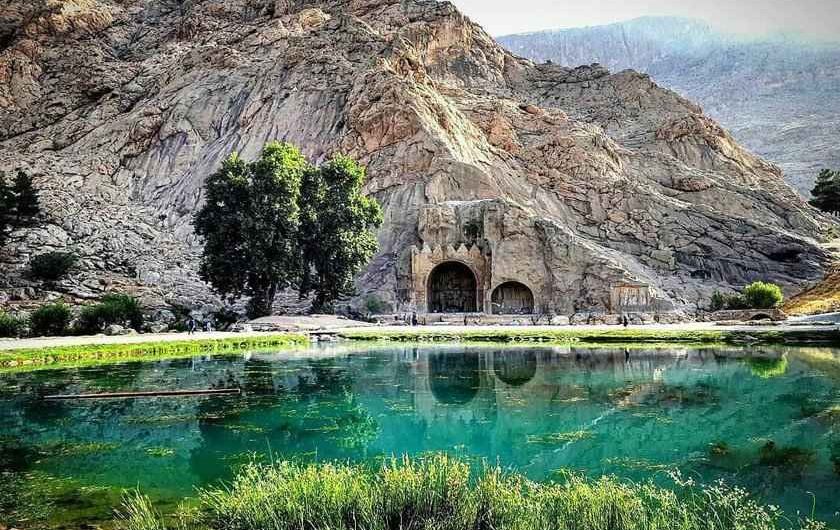Kermanshah
This historic city, dating from the 4th century BC. is surrounded by the Zagros mountains, on the border of Iranian Kurdistan and Iraq, and with the Behistun as the highest peak it becomes one of the most picturesque cities in the country. Due to its pleasant and temperate climate, Kermanshah was the second capital during Sassanid times. Some pieces of stones discovered in the Kermanshah caves are estimated to be 200,000 years old, belonging to the primary human beings.
This city serves as a base to know the prodigious reliefs of Behistun, remaining from the Achaemenid period, registered as a World Heritage Site by UNESCO in 2006. From an economic point of view, Kermanshah is an important commercial center in the west of the country, focused on agriculture and industry. The region is an important producer of wheat, vegetables and fruits, and also contains agri-food factories (sugar, oil, flour), cement and textiles.
Moaven ol-Molk Mosque
A shrine dedicated to Imam Hossein built in 1886 by Moaven ol-Molk. Converted into the venue for religious ceremonies, it consists of three parts: Hosseiniyeh, Zeinabiyeh and Abbasiyeh. Both its exterior and interior are decorated with polychrome tiles. The enclosure has two patios and a main room with stained glass and a dome. The interior is adorned with paintings of bloody scenes of religious battles, animals, characters of the time and of kings, and cities.
To get to Hosseiniyeh, you have to go down 17 steps as the structure is six meters below street level. Hosseiniyeh has a small courtyard surrounded by several rooms and decorated with blind arcades.
Abbasiyeh consists of a courtyard and a two-story building on the east side with the walls decorated with tiles.
Zeinabieh, on the other hand, houses the tomb of Moaven al-Molk.
Taq-e Bostan
A series of reliefs and inscriptions carved into the rock, belonging to the Sassanid period in the 3rd century AD. In this place are the reliefs of the coronation of the Sassanid kings such as that of Ardeshir II, together with the gods Ahura Mazda and Mitra, that of Shapur II and his son Shapur III, and that of Khosrow Parviz, together with Ahura Mazda and the goddess Anahita, as well as inscriptions in Pahlavi script and captured moments of haunted animals. The content of the inscriptions deals with the presentation of the king and the worship of God. The small cave houses the reliefs of kings Shapur II and Shapur III, while the large cave, built in the 6th century, contains those of Khosrow II and the gods. Under the arch on the sides there are two reliefs with quintessential hunting scenes that feature abundant detail.
Behistun
On the holy mountain of Behistun, located in the Kermanshah province in western Iran, there is an extraordinary multilingual inscription (Elamite, Babylonian and ancient Persian) carved into a limestone cliff about 60 meters above the plain. This site is located on one of the main routes connecting Persia to Mesopotamia and the inscription is illustrated by a life-size bas-relief of its creator, Darius I, and other figures. The inscription, being the only Achaemenid monumental inscription, is of great importance as it documents a specific historical event: the reestablishment of the Persian Empire by Darius I the Great.
Furthermore, Behistún is a testimony to the exchange of human values throughout the development of monumental art and writing, reflecting ancient traditions in monumental bas-reliefs. The inscription was the first cuneiform writing, 15 meters high and 25 meters wide. This writing, whose great part covers the victories of Darius I over numerous pretenders to the throne, was created in the year 521 BC. Once deciphered in the 19th century, other previously unknown aspects of ancient civilizations were discovered. The 187-hectare site of Behistún exhibits vestiges of prehistory up to the Middle Period (8th-7th centuries BC), as well as the Achaemenid (6th-4th century BC) and later periods. However, the most significant period is formed by the one which goes from the 6th century BC. to the 6th AD.
Khajeh Barukh Mansion
A historic house belonging to Khajeh Barukh, one of Kermanshah’s Jewish merchants, which was built in the time of Naser-al-Din Shah. The mansion is located in the Feyzabad Jewish Quarter, nowadays used as an artists’ home in Kermanshah.
Jomeh Shafei Mosque
This mosque, located in the city of Kermanshah, was the pilgrimage site of the city, which led to Javanshir Square on one side and Tarikeh Bazaar on the other. Built by a couple of Sunni benefactors, the mosque is somewhat inspired by the style of Turkish mosques. Established in 1945, this religious attraction enjoys a privileged status in the country, as the majority of Shiite Muslims respect Sunnis and other divine religions. The beautiful mosque highlights the elegant architecture typical of Islamic mosques. The intricate arches and pillars attract attention at first glance. The ceilings are impressively decorated with floral motifs. The mosque also has delicate stucco work adorned with verses from the Koran. In the main prayer room, arched windows can be seen that let in the sunlight during the day.
Kermanshah Bazaar
It is located near the Shafei Mosque and is the main commercial center of the city. The bazaar, with its labyrinthine alleys, its beautiful architecture and many local products, including the typical sweets made with rice flour, amazes visitors.
Anahita Temple
A historical temple dating back to the Parthian and Sassanid era, located in the city of Kangavar. According to the ancient Persians, Anahita is the goddess and guardian of water, vegetation and beauty. The monument has an area of 5 hectares where some columns with a height of 50 meters have still persisted.



Comments